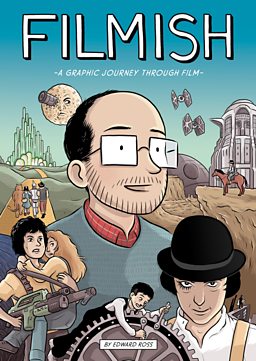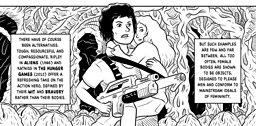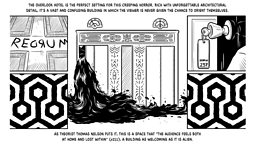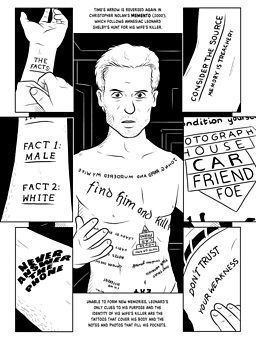Graphic scenes: Comic artist dissects Star Wars, Metropolis & The Shining
12 November 2015
This week sees the publication of Filmish: A Graphic Journey Through Film by Edinburgh-based writer and illustrator EDWARD ROSS. His first graphic novel, it’s a mix of film history and analysis which is designed to shed new light on the movies we love and also expose readers to some films they may not have encountered before. Here, he writes about how the ideas for the book developed.

From childhood, films and comics have battled each other for my affections. Growing up on a steady diet of The Beano, Calvin and Hobbes and Peanuts, I spent a large chunk of my childhood creating my own comic characters and comic books. Meanwhile, film enthralled me and as I grew up I consumed as much as I could, exploring everything from Indiana Jones to Breathless.
Working in Edinburgh’s Filmhouse after graduation, I finally found an opportunity to bring these two passions together, creating a short comic about the role of food on film for the cinema’s marketing department.
Comics can bridge the gap between the medium of cinema and the world of film-analysis
From there the idea for a comic about film took shape and I began self-publishing issues of Filmish and selling them at Filmhouse, the BFI and comic shops across the country.
Immediately popular with film fans, Filmish appealed to British comics publisher SelfMadeHero too, who saw my plans for a book-length version of Filmish and wanted to publish it.
The idea of using comics as a way to celebrate film is not an immediately obvious one, but comics are an excellent medium for the dissection and appreciation of cinema. A hybrid form of words and pictures, comics can bridge the gap between the profoundly visual medium of cinema and the normally text-based world of film-analysis.
The art in Filmish is about more than just reproducing movie scenes in a photorealistic way - each image is a chance to put my own visual spin on famous movies, using my black and white linework to reinterpret classic scenes and shed new light on them.

Aliens, 1986

Breathless, 1960

The Shining, 1980

Filmish was a real joy to research, giving me a chance not only to watch some of the medium’s greatest works again, but also a chance to see those films from a new perspective.
It’s no accident that most heroic characters in Star Wars hail from rural, natural environments; as stark an opposition as possible to the harsh, metallic machinery of the Death Star
One of my favourite chapters is about the role that setting has in creating truly memorable movies. The places movie characters inhabit can tell us a lot about them, an idea beautifully illustrated by the Star Wars saga.
As I argue in the book, it’s no accident that most heroic characters in Star Wars hail from rural, natural environments; as stark an opposition as possible to the harsh, metallic machinery of the Death Star.
In those films each setting is a way to further enrich our understanding of its inhabitants, and I think the powerful symbolism of Star Wars’ settings is one of the reasons those movies have captured the imaginations of so many.
Star Wars, 1977

Ultimately, Filmish is about watching films in a new way, and trying to better understand how they communicate with us.
Look at how often James Bond is matched against an enemy who is scarred, deformed or in some way disabled
Film doesn’t exist in a vacuum and the movies can profoundly affect the way we see the world around us. Part of the book discusses the ways that film shapes our cultural understanding of the human body.
As I show in the book, all too often movies use disability as a way to signal to viewers that a character is a villain. From Dr. No to Spectre, just look at how often James Bond is matched against an enemy who is scarred, deformed or in some way disabled.
While it may seem like an incidental thing to many viewers, these repeated motifs can have real-world effects, both for people with disabilities who struggle to find positive representation onscreen, and those without, who may be influenced by such negative portrayals.

Filmish was a real pleasure to work on, and the journey from creating self-published comics to having my first book published has been quite an adventure.
My hope is that readers discover something new about cinema
My hope is that readers discover something new about cinema by reading Filmish, whether they’re viewers just beginning to discover the hidden delights of film history or long-time movie-buffs who have seen it all.
That’s the purpose of Filmish: to shed new light on the movies we love and allow us to see this amazing medium in entirely new ways.
Filmish is published by SelfMadeHero on November 12, 2015.
Metropolis, 1927

A Clockwork Orange, 1971

Memento, 2000

Related Articles
-
![]()
Phonographics
Albums covered by comic book artists
-
![]()
Comic timing
Frank Quitely's work on comics such as X-Men, Batman and Superman
-
![]()
The Lady in the Van
Alan Bennett and Nicholas Hytner on their film adaptation
-
![]()
Film Mavericks
Film critic Danny Leigh profiles the mavericks and rebels of British cinema
More from BBC Arts
-
![]()
Picasso’s ex-factor
Who are the six women who shaped his life and work?
-
![]()
Quiz: Picasso or pixel?
Can you separate the AI fakes from genuine paintings by Pablo Picasso?
-
![]()
Frida: Fiery, fierce and passionate
The extraordinary life of Mexican artist Frida Kahlo, in her own words
-
![]()
Proms 2023: The best bits
From Yuja Wang to Northern Soul, handpicked stand-out moments from this year's Proms








